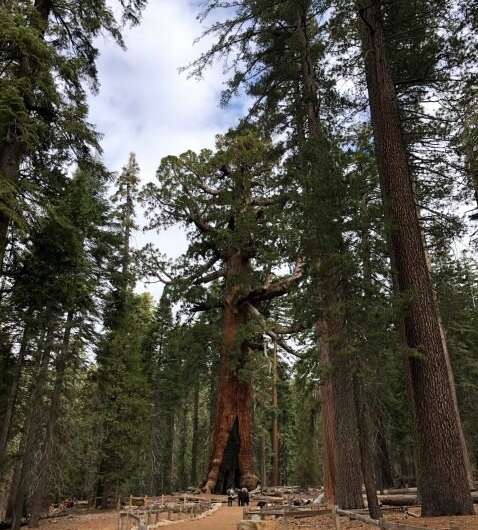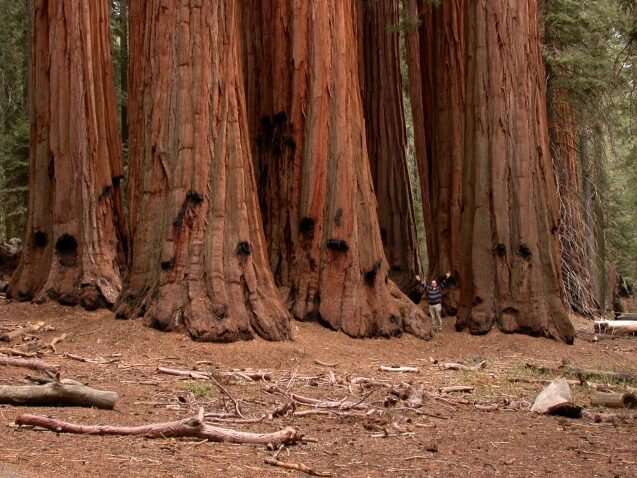Yosemite’s Grizzly Giant (center) stands as tall as the Statue of Liberty and is estimated to be nearly 3,000 years old. Credit: Kevin Webb
Last month, unusually high winds knocked down 15 giant sequoias in Yosemite. If you haven't had a chance to see them in person, giant sequoias are big—like, warp-your-sense-of-scale and melt-your-brain big. Then, once you've taken in their size, they do the same thing with your sense of time, because an individual tree can survive thousands of years. Wars, plagues, fashion trends: Sequoias have lived through and outlasted them all. To last thousands of years, any sequoia has also endured hungry animals, diseases, fires, snowstorms, El Niño events, and years-long droughts, not to mention the opportunistic loggers of the 19th and 20th centuries.
What a shame, then, for 15 trees to survive through so many challenges only to die in a windstorm. Sadly, this is a climate change story. While sequoias are wonderfully adapted to their narrow range in California's Western Sierras, this habitat has been unusually sensitive to changing weather patterns, and may be changing faster than sequoias can migrate or adapt. If we want to ensure these majestic trees' survival, it's time to consider planting a new generation of sequoias in colder, nearby habitats.
Although high winds in the Yosemite region are not unusual, last month's 80-mile-per-hour gusts were the most extreme in at least a decade, and caused the most damage to the park since flooding in 1997. Even if these high winds were unrelated to climate change, ongoing weather changes in the Sierras have produced more stressed trees. Shorter cold seasons have meant more rain instead of snow, which in winter can mean floods and mudslides. In warm seasons, there's less snowpack to feed the waterways that sequoias and other trees depend on to stay hydrated throughout the year, which in turn makes fires more likely. Hotter, drier summers force trees to make compromises to retain what little moisture they have, which then limits their ability to grow and repair themselves.
While a healthy sequoia can survive challenge after challenge, a stressed sequoia is more vulnerable to fire, disease, mudslides, and wind. And climate change will only make these events more frequent and extreme.
The best thing we can do to preserve the sequoias we have remaining is to slow, stop, and reverse climate change. With a path to returning to historic CO2 levels—roughly 270 atmospheric parts per million (PPM), vs. today's 415 PPM—forest managers could justifiably work to preserve existing groves through fire mitigation, supplementary water, and careful stewardship of young trees in existing groves. If these trees can survive with human help through several warmer decades or centuries, then climate change will have been just one more thing sequoias outlasted.
Another approach which deserves consideration, though, is assisted migration, where humans move organisms into new suitable habitat. An established form of assisted migration is reintroduction, where managers in areas where species have been recently eliminated introduce populations from nearby areas. This is how wolves were reintroduced to Yellowstone, from populations in nearby regions of Canada.
A more controversial, emerging form of assisted migration is in response to climate, where managers move populations to a totally new habitat because their existing one is now too warm, dry, or otherwise unsuitable. Mobile species typically do this on their own; in hotter periods, they seek cooler temperatures toward the poles or at higher elevations. In colder periods they do the reverse. This trend is so consistent that the EPA considers bird and marine animal movements in the past century an indicator of climate change.
But sequoias, of course, can't move easily. Their range hasn't changed in at least half a millennium, and even in ideal conditions, they are estimated to spread at maximum a mile every 300 years. This is doubly bad news since almost all of their population exists in the southernmost third of their range, far from cooler temperatures up north.
The House Group of giant sequoias in the Giant Forest grove, Sequoia National Park, California. Credit: Paul Rudenko
A second barrier is the human-built environment. Roads, agriculture, and buildings break up the landscape and limit many species' ability to move outward with time. Human use alters soil and light characteristics, which for plants may make formerly suitable habitat untenable.
Assisted migration, then, is a human-made solution for species that have to adapt for human-made reasons. Critics argue it's a distraction from addressing underpinning issues (namely, climate change and land use), and may even present a moral hazard: If we can preserve more species through moving them around, will that reduce the need to stop CO2 emissions? Further, any relocation of a species risks disrupting fragile ecosystems. Is it wise to save one species at the risk of potentially many others?
But let's turn back to giant sequoias, which are becoming strangers in their own land. If the climate conditions of some or all of their existing groves is already unsuitable, then what happens if global climate rises another 0.5 or full degree Celsius, as per Paris Agreement targets? Can spending precious resources to keep California's existing sequoia groves healthy really be justified, when every year California's bravest must deal with landscape-scale blazes? With care and luck, many sequoias will persist, but if we value these giants, we'd be wise to hedge our bets by creating backup groves in nearby habitats.
Because of their slow dispersal, long time to reproduce, scientific value, and sheer charisma, sequoias are ideal test subjects for how responsible assisted migration might work. Sites would be further north along the Sierras, where sequoias might have spread with longer time horizons and fewer manmade obstacles. Groves could be planted with genetically diverse seed stock, with enough seeds planted to allow natural selection to work. Partnered institutions and organizations would be responsible for ongoing study and monitoring for adverse consequences. If successful, methodologies could hopefully be re-used for many species facing similar fates. Even if groves throughout California were lost, there would then still be living, thriving trees whose seeds could someday repopulate their original territory.
Ultimately, I'm drawn to considering assisted migration because it is active and optimistic, when so much of conservation is necessarily about just slowing damage. Climate change is the mother of all collective action problems, where individuals' powerlessness can manifest as very real climate grief. Meanwhile, anyone with a yard or access to a park can advocate for species figuring out how to survive. If done responsibly, welcoming some species into new, relatively nearby homes would be an act of faith that there will be a place for the array of life that calls Earth home. It's faith that humans can be forces for more than destruction.
Perhaps ironically, sequoias have been instrumental in understanding climate change. Their annual rings created a record of seasons dating back millennia, which could be compared with other trees' around the world. Seesawing patterns of dry and wet spells across the globe have helped climatologists model complex, repeating weather patterns that show that yes, climate always changes, but also yes, what we're experiencing today is beyond what natural phenomena can explain. Further, sequoias' tree ring record is so reliable that when Willard Libby invented radiocarbon dating, he used sequoias to prove his technique worked. Radiocarbon dating, which can estimate the age of any organic matter from the past 50,000 years, has in turn shown how other species and human civilizations adapted to past climate fluctuations.
Extinction for a species as unique as sequoias would be devastating. If sequoias can persist, though, then someday thousands of years from now, their rings will again have a story to tell. This time, it will be the story of us: the story of how quickly we changed the planet, and the story of how we responded to a crisis of our own making.
I hope it's a good one.
Provided by Earth Institute at Columbia University
This story is republished courtesy of Earth Institute, Columbia University http://blogs.ei.columbia.edu.
























